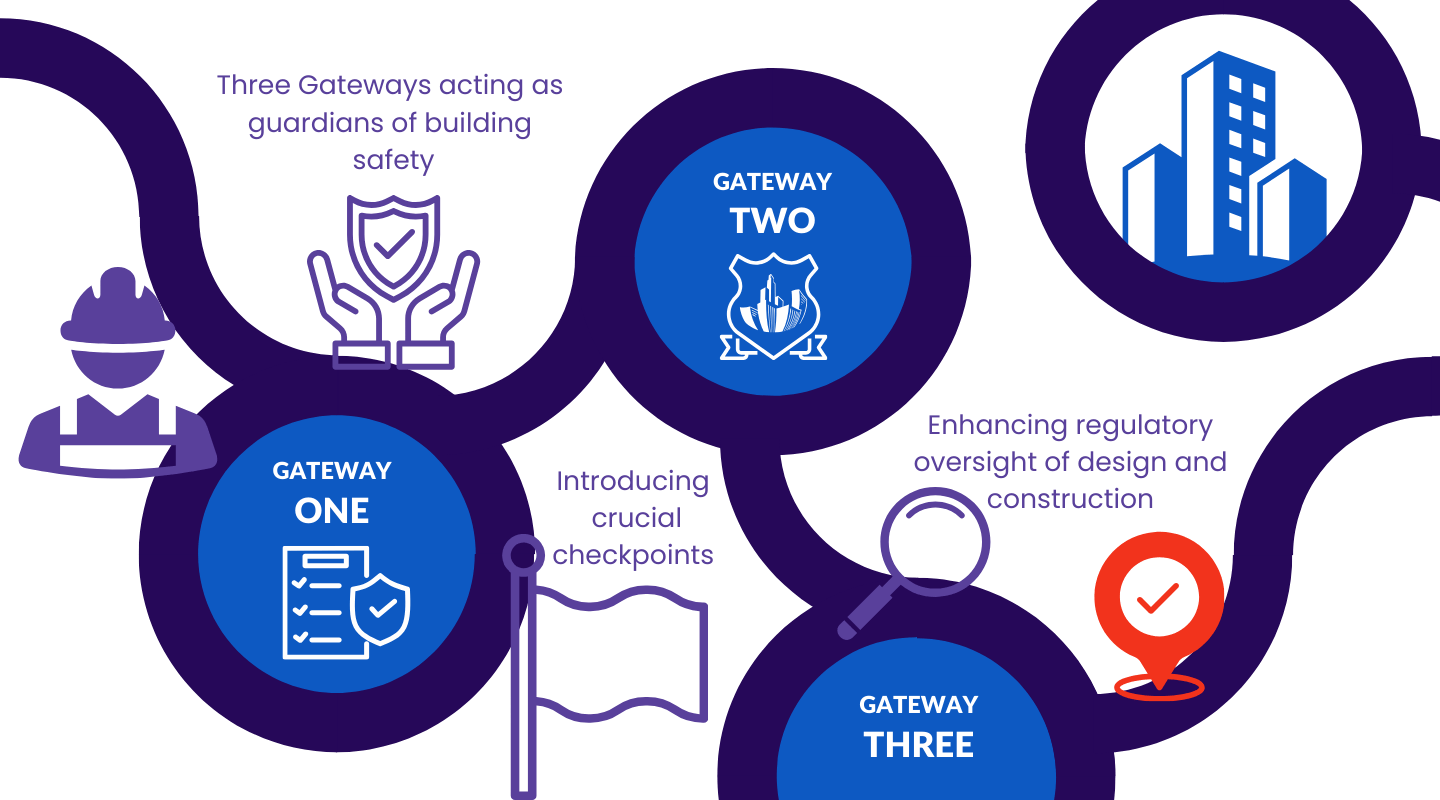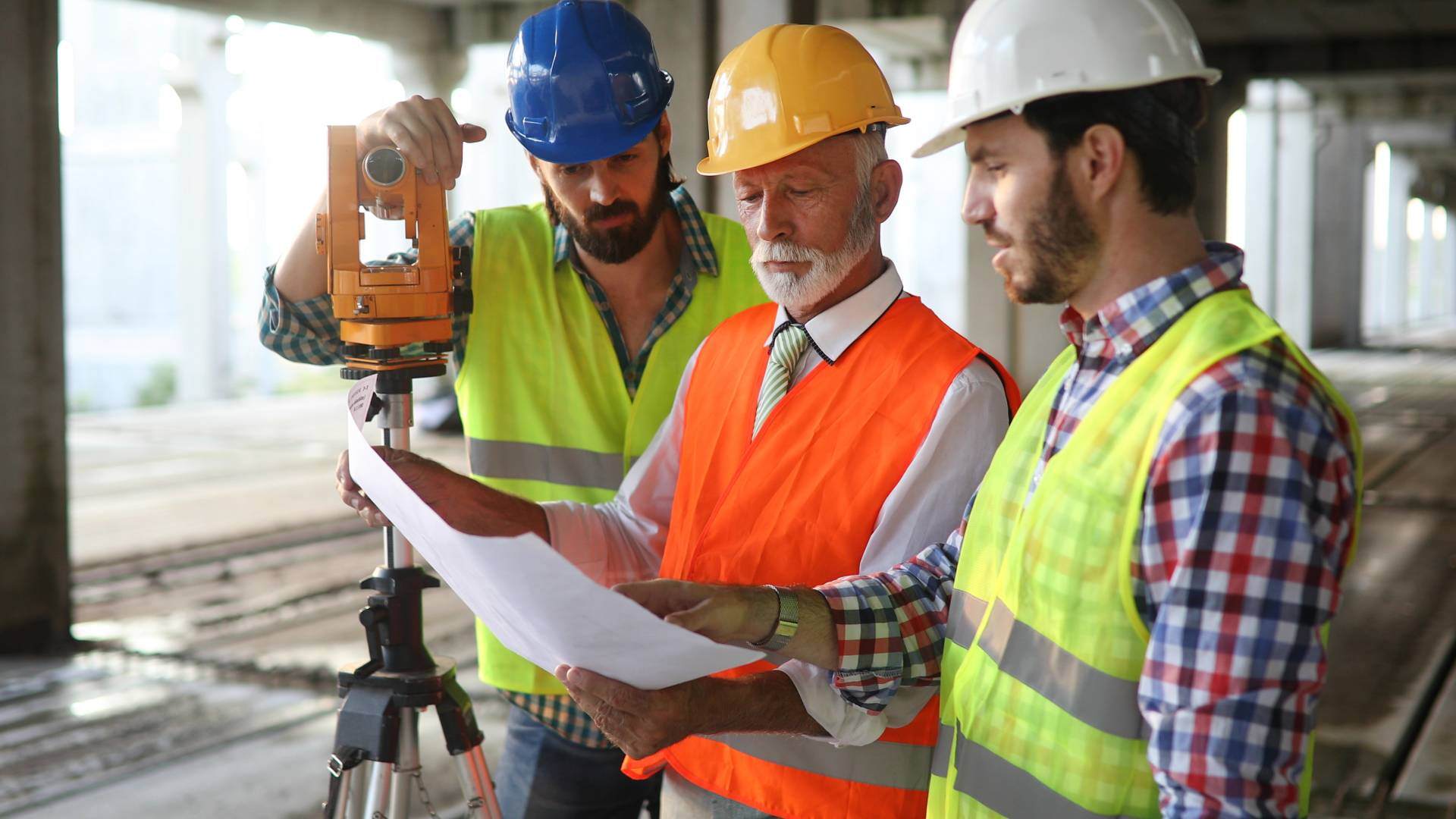
Understanding The Building Safety Act Gateways
The Building Safety Act, enacted in 2022, introduced a series of critical gateways to enhance safety standards and oversight for higher-risk buildings in the design, construction, and occupation phases.
The Building Safety Regulator need assurance and evidence that building safety issues have been properly considered at key stages of a project
- Gateway 1 focuses on obtaining planning permission by demonstrating the proposed design meets necessary safety requirements.
- Gateway 2 involves rigorous inspections during construction to verify adherence to approved plans.
- Gateway 3 ensures the building is fit for occupation
These gateways aim to improve accountability, facilitate early risk identification, ensure ongoing compliance, and establish clear documentation throughout a building's lifecycle. Failure to meet gateway requirements can result in penalties and project delays, underscoring the Act's importance in prioritising safety for high-risk buildings.

What Are The Building Safety Act Gateways?
The Building Safety Act Gateways are designed to provide a comprehensive safety framework throughout the lifecycle of a higher-risk building.
The Building Safety Act applies to higher-risk buildings, defined as:
- Buildings that are at least 18 metres tall or have at least 7 stories
- Residential buildings where people sleep, such as student accommodations, care homes, and hospitals
- Buildings with specific safety-critical systems or structural complexities
These criteria ensure that the most vulnerable and high-risk structures receive heightened attention and scrutiny under the Building Safety Act.
There are 3 gateways:
Gateway 1: Before planning permission is granted
Gateway 2: Before work can start
Gateway 3: Before the building can be occupied
By implementing these gateways, the Act aims to:
- Enhance accountability and responsibility among building owners, developers, and construction professionals
- Facilitate early identification and mitigation of potential safety risks
- Ensure ongoing compliance with safety regulations during construction and occupation
- Establish a clear audit trail for building safety documentation and decision-making processes
Navigating the Building Safety Act Gateways requires close collaboration between building owners, designers, contractors, and regulatory bodies. Failure to comply with the requirements set forth by these gateways can result in significant penalties and potential legal action.
What Is Building Safety Act Gateway 1
Gateway 1, also known as the Planning Gateway, is the first critical checkpoint in the Building Safety Act's framework. This gateway is encountered during the planning permission stage for higher-risk buildings. It serves as a crucial early intervention point, preventing the construction of buildings with inherent safety flaws or inadequate safety considerations.

What information is needed for Building Safety Act Gateway One
Planning Gateway One requires clients and designers to consider the fire safety needs as they relate to the project. This includes the submission of a full fire statement.
Client (individuals or organisations commissioning the project): Submits Fire Statement and planning application.
Principal Designer (individuals or organisations overseeing the design process): Prepares safe design.
The Health and Safety Executive, who is the statutory consultee for HRB (Higher-Risk Building) planning applications, will review the Fire Statement and provide advice to the Local Authority on fire safety matters. The Local Authority is responsible for granting planning permission.
Hospitals and care homes are excluded from Gateway One requirements.
Obtaining approval at Gateway 1 is a prerequisite for proceeding with the construction phase. The successful navigation of this gateway not only ensures compliance with safety regulations but also establishes a strong foundation for subsequent gateways. By addressing safety concerns early on, Gateway 1 aims to prevent costly remediation measures and potential safety hazards further down the line.
What Is Building Safety Act Gateway 2
Gateway Two is the second critical checkpoint in the Building Safety Act's framework, occurring during the construction phase of higher-risk buildings. This gateway focuses on ensuring that the practical implementation of the approved design adheres to the necessary safety standards and requirements. This gateway ensures that no deviations from the original design occur, safeguarding the integrity of the building's safety features.

What information is needed for Building Safety Act Gateway Two
At this stage, building control bodies conduct rigorous inspections and assessments to verify that the construction process aligns with the plans and specifications approved during Gateway 1. They examine the materials, workmanship, and installation of critical safety systems, such as fire safety measures, structural elements, and safety-critical systems.
The Client (individuals or organisations commissioning the project) must submit evidence of:
- Compliance with Building Regulations
- Provision of full plans
- Appointment of competent people
- Application for Building Control Approval
Any alterations to current plans must be documented in a change control log. Under the Building Safety Act, these modifications are categorised as either:
- Major changes, which necessitate an application to the Regulator and approval before work can start.
- Notifiable changes, where work can commence once the Regulator has been informed.
Failure to meet the requirements at Gateway 2 can result in the suspension of construction activities or the imposition of penalties until the necessary corrections are made. Successful navigation of Gateway 2 is crucial to ensuring that the completed building meets the highest safety standards and is ready for occupation.
The Regulator is requesting both the narrative and supporting evidence explaining how the building design complies with Building Regulations. If adequate information, evidence, and justification are not provided for the Regulator to assess compliance with the building(s) functional requirements, it will cause delays in this Gateway process.Exclusive BESA Member Access to Build UK’s Gateway 2 Validation Guide
Build UK has published a comprehensive guide on the validation stage at Gateway 2, this guide outlines the necessary documents for Building Control Approval applications to the Building Safety Regulator (BSR) for Higher-Risk Buildings (HRBs).
The guide also highlights the essential documentation required for both new and existing HRBs to improve the success rate of applications, as nearly 30% of current submissions are found to be invalid. BESA Members can log in to the member area here for exclusive access here.
What information is needed for Building Safety Act Gateway Three
At this stage, the client submits an application for a completion certificate, providing evidence that the building has been constructed according to the approved plans.
At this stage the Client must submit evidence to:
- Demonstrate the building is safe to occupy
- Apply for the completion certificate
- Show ongoing management plans
The Principal Contractor must hand over the Golden Thread of building and operational information.
The Gateway 3 process involves a thorough assessment by the Building Safety Regulator, who reviews the submitted documentation and conducts on-site inspections to verify compliance. This gateway also addresses the appointment of a Building Safety Manager, responsible for overseeing the building's safety throughout its operational life.
Occupancy of the building is only lawful once the completion certificate has been issued. The Building Safety Regulator may take enforcement action if a building is occupation without a completion certificate.
Once the Completion Certificate is issued the Principal Accountable Person (PAP) must register the Building with the Regulator.
This final checkpoint serves as a safeguard, ensuring that all necessary safety measures have been implemented and that the building adheres to the highest standards set forth by the Building Safety Act. Failure to meet the requirements at this stage can result in significant penalties and potential legal consequences.
Navigating the Building Safety Act's requirements can be daunting. As a BESA member, you'll have access to comprehensive resources to guide you through the process. Our tailored membership benefits include:
- The Building Safety Act Hub with the latest information, advice, and guidance to achieve and maintain compliance seamlessly.
- Experts providing personalised support to develop effective compliance strategies for your business.
- Ongoing updates on evolving regulations and best practices.
Latest Building Safety Act News From BESA
2 min read
BESA suspends more members
5 min read
Contractors given stark bribery warning
2 min read

